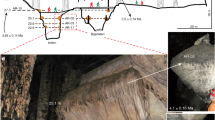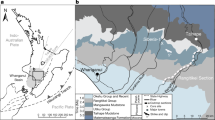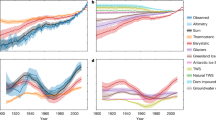Abstract
Proxy data suggest that atmospheric CO2 levels during the middle of the Pliocene epoch (about 3 Myr ago) were similar to today, leading to the use of this interval as a potential analogue for future climate change. Estimates for mid-Pliocene sea levels range from 10 to 40 m above present, and a value of +25 m is often adopted in numerical climate model simulations. A eustatic change of such magnitude implies the complete deglaciation of the West Antarctic and Greenland ice sheets, and significant loss of mass in the East Antarctic ice sheet. However, the effects of glacial isostatic adjustments have not been accounted for in Pliocene sea-level reconstructions. Here we numerically model these effects on Pliocene shoreline features using a gravitationally self-consistent treatment of post-glacial sea-level change. We find that the predicted modern elevation of Pliocene shoreline features can deviate significantly from the eustatic signal, even in the absence of subsequent tectonically-driven movements of the Earth’s surface. In our simulations, this non-eustatic sea-level change, at individual locations, is caused primarily by residual isostatic adjustments associated with late Pleistocene glaciation. We conclude that a combination of model results and field observations can help to better constrain sea level in the past, and hence lend insight into the stability of ice sheets under varying climate conditions.
This is a preview of subscription content, access via your institution
Access options
Subscribe to this journal
Receive 12 print issues and online access
$259.00 per year
only $21.58 per issue
Buy this article
- Purchase on Springer Link
- Instant access to full article PDF
Prices may be subject to local taxes which are calculated during checkout



Similar content being viewed by others
References
Intergovernmental Panel on Climate Change Fourth Assessment Report available at: http://www.ipcc.ch/ipccreports/ar4-syr.htm (2007).
Haywood, A. M., Valdes, P. J. & Sellwood, B. W. Global scale palaeoclimate reconstruction of the middle Pliocene climate using the UKMO GCM: Initial results. Glob. Planet. Change 25, 239–256 (2000).
Haywood, A. M. & Valdes, P. J. Modelling Middle Pliocene warmth: Contribution of atmosphere, oceans and cryosphere. Earth Planet. Sci. Lett. 218, 363–377 (2004).
Chandler, M., Rind, D. & Thompson, R. Joint investigations of the Middle Pliocene climate II: GISS GCM Northern Hemisphere results. Glob. Planet. Change 9, 197–219 (1994).
Sloan, L. C., Crowley, T. J. & Pollard, D. Modelling of Middle Pliocene climate with the NCAR GENESIS general circulation model. Mar. Micropaleontol. 27, 51–61 (1996).
Pagani, M., Liu, Z., LaRiveire, J. & Ravelo, A. C. High Earth-system climate sensitivity determined from Pliocene carbon dioxide concentrations. Nature Geosci. 3, 27–30 (2010).
Dowsett, H. J. in Deep-time Perspectives on Climate Change: Marrying the Signal from Computer Models and Biological Proxies (eds Williams, M., Haywood, A. M., Gregory, J. & Schmidt, D.) 459–480 (The Micropalaeontological Society Special Publications The Geological Society of London, 2007).
Pollard, D. & De Conto, R. M. Modelling West Antarctic ice sheet growth and collapse through the past five million years. Nature 458, 329–332 (2009).
Moucha, R., Forte, A. M., Mitrovica, J. X., Rowley, D. B & Quéré, S. Dynamic topography and long-term sea-level variations: There is no such thing as a stable continental platform. Earth Planet. Sci. Lett. 271, 101–108 (2008).
Farrell, W. E. & Clark, J. A. On postglacial sea level. Geophys. J. R. Astron. Soc. 46, 647–667 (1976).
Mitrovica, J. X. & Milne, G. A. On post-glacial sea level. I. General theory. Geophys. J. Int. 154, 253–267 (2003).
Kendall, R. A., Mitrovica, J. X. & Milne, G. A. On post-glacial sea level: II. Numerical formulation and comparative results on spherically symmetric models. Geophys. J. Int. 161, 679–706 (2005).
Mitrovica, J. X., Wahr, J., Matsuyama, I. & Paulson, A. The rotational stability of an ice age Earth. Geophys. J. Int. 161, 491–506 (2005).
Mitrovica, J. X. Recent controversies in predicting post-glacial sea-level change: A viewpoint. Quat. Sci. Rev. 22, 127–133 (2003).
Lambeck, K. & Chappell, J. Sea level change through the last glacial cycle. Science 292, 679–686 (2001).
Kopp, R. E., Frederik, S. J., Mitrovica, J. X., Maloof, A. C. & Oppenheimer, M. Probabilistic assessment of sea level during the last interglacial stage. Nature 462, 863–868 (2009).
Dziewonski, A. M. & Anderson, D. L. Preliminary reference Earth model (PREM). Phys. Earth Planet. Int. 25, 297–356 (1981).
Peltier, W. R. Global glacial isostasy and the surface of the ice-age Earth: The ICE-5G (VM2) model and GRACE. Annu. Rev. Earth Planet. Sci. 32, 111–149 (2004).
Lambeck, K., Smither, C. & Johnston, P. Sea-level change, glacial rebound and mantle viscosity for northern Europe. Geophys. J. Int. 134, 102–144 (1998).
Mitrovica, J. X. & Forte, A. M. A new inference of mantle viscosity based on a joint inversion of convection and glacial isostatic adjustment data. Earth Planet. Sci. Lett. 225, 177–189 (2004).
Lisiecki, L. E. & Raymo, M. E. A Pliocene–Pleistocene stack of 57 globally distributed benthic δ18O records. Paleoceanography 20, PA1003 (2005).
Bamber, J. L., Layberry, R. L. & Gogineni, S. P. A new ice thickness and bed data set for the Greenland ice sheet; 1. Measurement, data reduction, and errors. J. Geophys. Res. 106, 33773–33780 (2001).
Lythe, M. B. & Vaughan, D. G. The BEDMAP Consortium, BEDMAP: A new ice thickness and subglacial topographic model of Antarctica. J. Geophys. Res. 106, 11335–11351 (2001).
Mitrovica, J. X. & Milne, G. A. On the origin of postglacial ocean syphoning. Quat. Sci. Rev. 21, 2179–2190 (2002).
Kaufman, D. S. & Brigham-Grette, J. Aminostratigraphic correlations and paleotemperature implications, Pliocene–Pleistocene high-sea-level deposits, northwestern Alaska. Quat. Sci. Rev. 12, 21–33 (1993).
Dowsett, H. J. & Cronin, T. M. High eustatic sea level during the middle Pliocene: Evidence from the southeastern US Atlantic Coastal Plain. Geology 18, 435–438 (1990).
Krantz, D. E. A chronology of Pliocene sea-level fluctuations: The US Middle Atlantic coastal plain record. Quat. Sci. Rev. 10, 163–174 (1991).
Wardlaw, B. R. & Quinn, T. M. The record of Pliocene sea-level change at Enewetak Atoll. Quat. Sci. Rev. 10, 247–258 (1991).
James, N. P., Bone, Y., Carter, R. M. & Murray-Wallace, C. V. Origin of the late Neogene Roe Plains and their calcarenite veneer: Implications for sedimentology and tectonics in the Great Australian Bight. Aust. J. Earth Sci. 53, 407–419 (2006).
Sandiford, M. & Quigley, M. TOPO-OZ: Insights into the various modes of intraplate deformation in the Australian continent. Tectonophysics 474, 405–416 (2009).
Dahlen, F. A. The passive influence of the oceans on the rotation of the Earth. Geophys. J. R. Astron. Soc. 46, 363–406 (1976).
Acknowledgements
Support for this research was provided by NSF-OCE0825293 to M.E.R. and by Harvard University and The Canadian Institute for Advanced Research to J.X.M. We thank T. Cronin and J. Brigham-Grette for discussions of field data and support from the USGS PRISM program that helped jump-start this investigation.
Author information
Authors and Affiliations
Contributions
M.E.R. and J.X.M. jointly conceived and designed the GIA model experiments and wrote first draft of paper; J.X.M. carried out the GIA experiments; R.M.D. provided ice sheet simulations; M.J.O. and P.J.H. contributed to analysis of geologic data; all authors contributed to discussions and revisions of the manuscript.
Corresponding author
Ethics declarations
Competing interests
The authors declare no competing financial interests.
Supplementary information
Supplementary Information
Supplementary Information (PDF 412 kb)
Rights and permissions
About this article
Cite this article
Raymo, M., Mitrovica, J., O’Leary, M. et al. Departures from eustasy in Pliocene sea-level records. Nature Geosci 4, 328–332 (2011). https://doi.org/10.1038/ngeo1118
Received:
Accepted:
Published:
Issue Date:
DOI: https://doi.org/10.1038/ngeo1118
This article is cited by
-
Influence of reef isostasy, dynamic topography, and glacial isostatic adjustment on sea-level records in Northeastern Australia
Communications Earth & Environment (2023)
-
Total isostatic response to the complete unloading of the Greenland and Antarctic Ice Sheets
Scientific Reports (2022)
-
Higher than present global mean sea level recorded by an Early Pliocene intertidal unit in Patagonia (Argentina)
Communications Earth & Environment (2020)
-
Constraints on global mean sea level during Pliocene warmth
Nature (2019)





